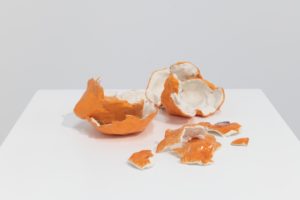Queer Futurities: holding area, gathering place is a new exhibit at Open Space that highlights sociological ideas such as queer futurity and forward-dawning as a way of combating fixtures in our hegemonic society. It achieves this through multidisciplinary art pieces created by 11 artists and curated by Dani Neira.
The first spark for Queer Futurities caught when Neira read queer theorist José Esteban Munoz’s novel Cruising Utopia, which explains that queer issues and news revolve too heavily around current topics.

“The book considers queerness as something that is future bound,” says Neira. “He’s looking at how queerness exists as this kind of ideology, something that’s on the horizon, and he enacts this queer temporality where he looks at the past, present, and the future, and looks at how we can glimpse these futurities in the present. But they only exist as these glimmers of a forward-dawning queerness.”
The idea of forward-dawning was a powerful image to Neira, whose exhibit started to take form from there. She made an open call for artists but asked for artistic practices and conversations rather than art.
“I delineated my concepts, and the different scenes I was thinking through, and I asked for submissions, not of artwork but artistic practices… And then the actual artwork came after conversations,” she says. “Some of them are new works created for the show, and some of them are pre-existing work.”
Neira was also inspired by the science-fiction works of Octavia Butler, specifically Parable of the Sower. Butler’s book made Neira think about the two questions that became the skeleton for Queer Futurities: how do we want to hold and be held? What do we want our communities to feel like?
“Over the pandemic, I got really into sci-fi and, specifically, speculative fiction, so I was reading Parable of the Sower… Throughout Butler’s books, there’s this necessity for networks of care and interdependence… And so those two questions came about from that type of query.”
Polyvocality—the use of different voices and perspectives—was crucial to answering these two questions.
“I wanted to allow for multiple entry points and discourses,” she says. “And so, by centring polyvocality, this project doesn’t aim to speak to, like, every queer experience. I’m more thinking about polyvocality as extending beyond the artist and into all of their queer relationalities, and how that extends into all of our communities.”
The exhibit is divided into the holding area and the gathering place. However, Neira says that they are interdependent upon one another and the exhibit’s overall message.
“Specifically for the exhibition holding area,” she says, “when thinking about holding, I was thinking a lot about the tenderness and affect in holding.”
After starting in the holding area, visitors will drift into the gathering place, where Neira says the focus is on community building and coming together.
“I wanted to centre the importance of community building, gathering, and multiple levels of access in the project,” she says, “and so rather than the community program part of gathering place… I wanted to centre that and wanted to give it its own part and its own artist, so it’s not just secondary to the exhibition itself.”
Neira wants Queer Futurities to be the start of a dialogue surrounding queer topics and a way to build relationships.
“For the queer community, I hope that the project either builds or nourishes relationships,” she says. “And as an extension of those relationships, the care and knowledge that comes from those relationships.”
Queer Futurities: holding area, gathering place
Until Saturday, July 23
Open Space
openspace.ca
